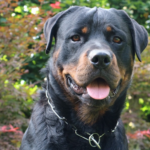Preventing nervous behavior in Rottweilers is an important task for pet owners. Rottweilers are large and powerful dogs, but they can also be sensitive and prone to anxiety. Your Rottweiler will be happier and healthier if you know what makes him or her nervous and take steps to stop it.
RELATED TOPICS:
- Managing Dominant Behavior in German Shepherds and Rottweilers
- Rottweiler Behavior: Understanding the Characteristics of the Breed
- Common Rottweiler Puppy Behavior Issues and Solutions
- Raising a Happy and Well-Behaved 8 Week Old Rottweiler
One of the main causes of nervous behavior in Rottweilers is a lack of socialization. Rottweilers that are not properly socialized from a young age may become anxious and nervous around new people and animals. To prevent this, it is important to expose your Rottweiler to a variety of different people, animals, and environments from an early age. This can help them learn to adapt and feel more comfortable in new situations.
Another common cause of nervous behavior in Rottweilers is a lack of exercise. Rottweilers are active and energetic dogs that require regular exercise to stay healthy and happy. Without enough physical activity, Rottweilers may become restless and anxious. To prevent this, make sure your Rottweiler is getting at least an hour of exercise per day. This can include walks, runs, or playtime in a securely fenced yard.
Another important factor in preventing nervous behavior in Rottweilers is providing a consistent and stable environment. Rottweilers thrive on routine and predictability, so it’s important to maintain a consistent schedule for meals, walks, and playtime. Additionally, providing a safe and comfortable living space that is familiar to the dog can help them feel more secure.
It’s also important to consider the diet of your Rottweiler, as certain nutrients can affect their behavior. It is recommended to consult with a veterinarian to ensure that your Rottweiler is getting all the necessary nutrients.
Finally, it is important to address any specific issues that may be causing nervous behavior in your Rottweiler. If you notice that your Rottweiler is particularly anxious or nervous in certain situations, it is important to consult with a professional trainer or behaviorist to help you identify and address the underlying problem.
What Are Signs Of Anxiety In Dogs?
Recognizing the signs of anxiety in dogs is important for ensuring their well-being. Some common signs of anxiety in dogs include panting, whining, shaking, destructive behavior, and elimination accidents. Dogs who are anxious may also exhibit changes in their eating or sleeping habits. They may become more clingy and follow their owners around the house.
In severe cases, dogs may even develop aggressive behavior. It’s important to note that not all dogs will show the same signs of anxiety, and it’s important to pay attention to your dog’s behavior and any changes in it.
If you suspect that your dog is suffering from anxiety, it’s important to consult with a veterinarian or a professional dog trainer to develop a plan to help them.
What Triggers Dog Anxiety?
Dogs, like humans, can experience anxiety due to a variety of triggers. Some of the most common triggers for dog anxiety include:
- Separation anxiety: Dogs can become anxious when separated from their owners or familiar people.
- Environmental changes: Moving to a new home, changes in the home’s layout or traveling can cause anxiety in dogs.
- Loud noises: fireworks, thunderstorms, and other loud noises can be very stressful for dogs.
- Changes in the household: The arrival of a new baby, a new pet, or a family member moving away can cause anxiety in dogs.
- Medical conditions: Dogs with certain medical conditions may become anxious as a result of their illness or treatment.
- Lack of socialization: Dogs that have not been properly socialized may become anxious in new or unfamiliar situations.
It’s important to note that triggers for dog anxiety can be different for each dog, and it’s important to observe and understand your dog’s behavior to identify the triggers. Once you identify the triggers, you can take steps to prevent or reduce the anxiety.
In some cases, a dog’s anxiety may be caused by a combination of triggers. For example, a dog that is prone to separation anxiety may become more anxious during thunderstorms. A consultation with a veterinarian or a professional dog trainer is highly recommended to develop a plan to help your dog manage their anxiety.
What Are The First Signs Of Stress In A Dog?
Assuring a dog’s health requires knowing how to spot the early warning signs of stress. Among the earliest indicators of stress in canines, the most common ones are:
- Panting or heavy breathing
- Yawning or lip-licking
- Whining or barking
- Trembling or shaking
- Dilated pupils
- Loss of appetite
- Changes in sleep patterns
- Decreased energy or interest in play
- Avoiding eye contact or hiding
- Urination or defecation outside of the designated area
Some dogs may exhibit more subtle signs of stress, and it’s important to remember that not all dogs will exhibit the same symptoms of anxiety. Pay close attention to your dog’s behavior, especially if you notice any changes.
If you notice signs of stress in your dog, you can take steps to ease his or her anxiety right away. Consult your doctor or a professional dog trainer if you observe any of these symptoms so that you can identify the source of your dog’s stress and work with them to find solutions.
Final Thoughts About Preventing Nervous Behavior in Rottweilers
In conclusion, preventing nervous behavior in Rottweilers is a multi-faceted task that requires attention to socialization, exercise, environment, diet, and addressing specific issues. With the right care and attention, Rottweilers can be calm, confident, and happy pets.







